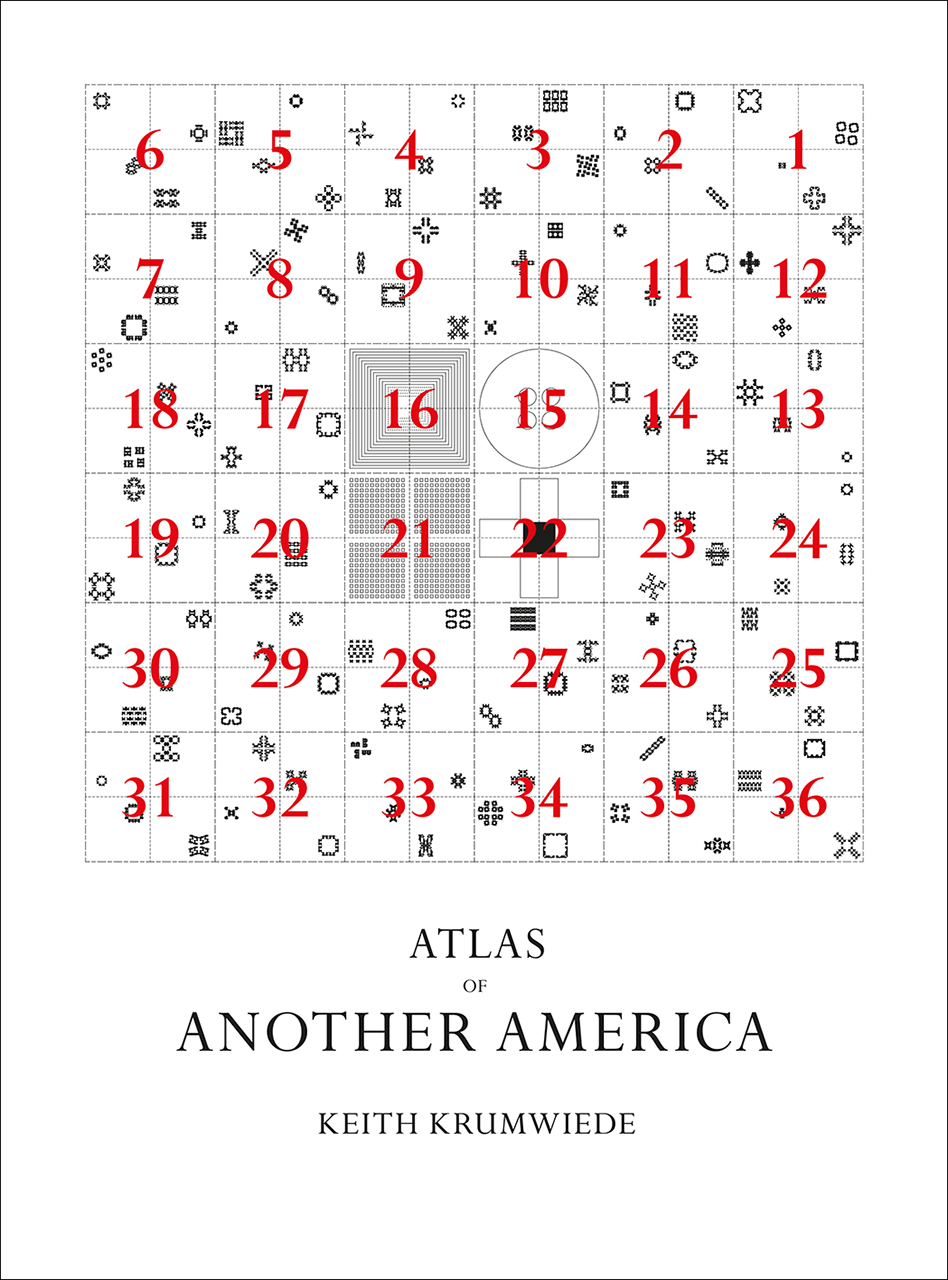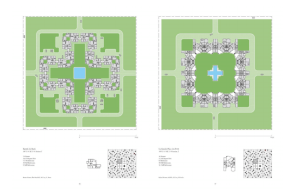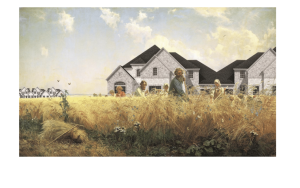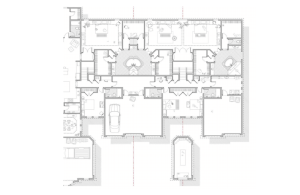Keith Krumwiede
Park Books

Freedomland is a fictional utopia that takes us on a tour of future settlements in the USA. Like so many visionary worlds (Joseph Conrad’s Heart of Darkness, H. G. Wells’s Time Machine or Fred M. Wilcox’s Forbidden Planet), it converts observations about our current world into a cautionary tale of a world to come. Freedomland appears to be a reboot of contemporary suburbia, as seen through the eyes of the Founding Fathers. Krumwiede explores the implications of hybridizing Jefferson’s 1785 Land Ordinance with current suburban practice. The Atlas begins innocently enough with the noble intention to plan “a rural democratic society of citizen farmers” (7). Krumwiede adopts a tract of land in accordance with Jefferson’s 1785 Land Ordinance and subdivides it into a patchwork of farmland and residential estates. Collections of these estates then form towns with a civic core of waste treatment and solar farms. In short, Krumwiede explores the popularity of the single-family homes that form the suburban grids surrounding our cities today.

Krumweide’s parody of Jeffersonian language hints at the ambiguity explored over the next 153 pages. He offers a “Catalogue of Estates” that range in size from eight to sixty-four residential units. He creates each estate from a typical suburban house plan, “drawn from the country’s greatest builders” (8), which he multiplies into configurations of high-density living. The result is 128 unique amalgamations of typical single-family houses packed together as collective living. For example, plans from Pulte Homes and David Weekley Homes are combined into a cloverleaf arrangement and a Corbusian cruciform block, respectively (Figure 1). These plan compositions remind me of late-modernist projects that introduce a familial quality to the megastructure. The cruciform plan shares similarities with Ricardo Bofill’s plans for the Muralla Roja and Xanadù housing projects. Each estate is rendered in perspective and collaged into a scene taken from a picturesque painting. In these images, the excessive repetition of gables in the middle ground of Arcadian settings distorts the conventional archetype of the suburban house (Figure 2).

Krumwiede experiments further with the language of suburbia in “Farming and Rotation of the Houses” (23). In this section, he applies Weekley’s promise of fast-track construction to the history of communal-building practices and localized farming, recalling nineteenth-century settlements like the Amana colonies in Iowa or the Shaker colonies in Pennsylvania. How often do we hear of neighborliness justified (in some rather distant way) in terms of communal barn raising? Krumwiede recognizes this justification by suggesting that each estate is periodically dismantled and relocated in accordance with both the desire for perpetual newness and the practice of crop rotation. The point is that agrarian practices might inform the urbanism of system-built communities.
The strength of the Atlas lies in Krumwiede’s ability to convince us of the plausibility of very unusual scenarios, delivered in a uniquely deadpan way. He is able to push the language of suburbia to credible extremes while remaining in character. For instance, he draws uncanny similarities between Archizoom’s critical narrative and the realities of projects such as Weekley’s “New Home Center” in Houston. For Krumwiede, it is a short step from Weekley’s promise of one-stop shopping to Archizoom’s No-Stop City of 1969, positing that Houston demarcates the birth of the uber-suburb. Archizoom’s vision, once marginalized as a theatrical reductio ad absurdum, seems prophetic today due to the rise of suburban grids in edge cities like Phoenix and Houston. More generally, Krumwiede’s drawings allow comparisons with books such as Lars Lerup’s One Million Acres & No Zoning and Sir Peter Cook’s Super Houston. Perhaps Krumwiede is as guilty as anyone when he falls under the spell the dystopian extreme and endless repetition. His work contains an element of guilty pleasure and a lust for a new sublime picturesque.

Krumwiede’s most convincing project appears in the final pages, which, quite oddly, makes it seem like an afterthought. Borrowing its title from Dan Graham’s photo-essay “Homes for America” (1966–67), Krumwiede’s “New Homes for America” takes us into the mind of an architect pulling an all-nighter before a client presentation. We see her vision of enormous suburban houses she names “The Buckingham,” “Ledoux,” “Owen” and, tellingly, the “Fourier” (Figure 3). This vision is Krumwiede’s strongest example of what Albert Pope refers to as a “phalanstery” of suburban collective living (251). This plan is a radical departure from the single-family house, exploring the single-family home through a linear collage of typical floor plans. It places a new breed of suburbanites in a communal setting where they have direct access to each other’s lives. Reading from left to right, all the rooms are accessible across the multiple home units. In one layout, we see six fully laden dining tables, a scenario that implies that multiple families dine together. Krumwiede’s salacious mischief becomes evident at the right-hand end of the plan. Twin pedestal baths and giant walk-in closets are one thing, but what “couple” needs three WCs in in an en suite bedroom arrangement? The same goes for “The Fourier,” in which a master bedroom leads onto a twin master bedroom via an en suite bathroom with conjoined pedestal baths! What are the implications of this amalgamation of poolrooms, saunas, baths and music rooms all endlessly linked via Weekley’s design mantra of “flex space” and “sight lines”?
Overall, Atlas of Another America is a dense and fascinating book. What I find most remarkable is Krumweide’s ability to make vivid the hidden contradictions of an uber-homogenized suburban future. Whether read as a cautionary vision of McMansion complacency, a thoroughly researched typology of houses, or a sincere attempt to plan agrarian urbanism, the book documents a long and thrilling journey from Weekley’s collection of model homes on Houston’s Highway 290.
Endnotes:
Jason Griffiths is Associate Professor in the College of Architecture at the University of Lincoln Nebraska. In 2015 he held the Hyde Chair of Excellence and in 2017 was awarded the W. Cecil Steward Professorship. He received his Masters in Architecture with distinction from the Bartlett School of Architecture, UK in 1994. His book Manifest Destiny was published by the AA in 2011 and was the recipient of the Deutsches Architekturmuseum Book Award. He has also been published in the AA Files, 30 60 90, LA Times and Volume. He is the recipient of a 2017 USDA Forest Service Wood Innovations grant, a 2017 WoodWorks/ Wood Design Award, and the 2019 ACSA Design-Build Award. In 2017 he established PLAIN to integrate engineered lumber construction with design-build education. Work from his practice includes award-winning architectural competitions, residential projects, public art, and furniture.
How to Cite This: Griffiths, Jason. Review of Atlas of Another America: An Architectural Fiction, by Keith Krumwiede. JAE Online. December 18, 2019. http://www.jaeonline.org/articles/review/atlas-another-america#/.






